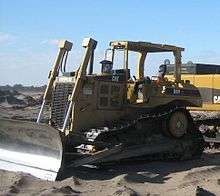Caterpillar D6
The Caterpillar D6 track-type tractor is a medium bulldozer manufactured by Caterpillar Inc. with a nominal operating weight of 18 tons. The military versions were classified as the SNL G152 medium tractor, under the G-numbers classification system used for army tractors.[1]
D6 Version history

The D6 started out in 1935 as the RD6, fitted with a 3-cylinder 45 hp D6600 engine. The numbering was changed to the D6 in 1937.[2] Caterpillar first introduced the entirely new D6 in 1941 with the 4R & 5R series. This was powered by the D4600 engine of 55 hp (drawbar).

- The D6 4R/5R was replaced by the D6 8U & 9U series, fitted with the 6-cylinder D318 engine of 66 hp, in 1947.
- In 1959 the D6 was replaced with the D6B after 60,000 D6 4R/5R and 8U/9U tractors had been built.
- In 1963 the D6C was introduced.
- In 1977 the D6D with a 140 hp engine was introduced, as well as the D6D SA version with 125 hp (drawbar) for agricultural use.
- The D6H was introduced in 1986 along with 3 other H-Series track-type tractors. This was the first D6 with Caterpillar's elevated drive sprocket undercarriage.
- The D6R replaced the D6H in 1996.
- The D6M was a LGP version with 140 hp.
- Since 1996 the D6K at 125 hp and 28,409 lb, the D6N at 150 hp and 36,497 lb and the D6T at 165 hp at 46,690 lb all have been introduced.
Dozer blades
The dozer blade on front of the tractor can come in different varieties:
- A straight blade ("S-Blade") which is short and has no lateral curve, no side wings, and can be used for fine grading.
- A universal blade ("U-Blade") which is tall and very curved, and has large side wings to carry more material.
- An "S-U" combination blade which is shorter, has less curvature, and smaller side wings.
- A Power Angle Tilt ("PAT") blade is a straight blade which has the ability to change the angle of the blade from side to side as well as the ability to hydraulically raise, tilt and angle the blade. This configuration is typically used in fine grading applications.
Rear equipment
The rear of the machine can be outfitted with various work tools to complement the front blade:
- The rear of the machine can have large slabs of steel to add weight to the rear of the machine to aid in heavy dozing applications.
- A drawbar and CCU (Cable control unit) for pulling towed scrapers and trailed implements; later models now use hydraulics in place of the CCU to operate scrapers.
- A hydraulic winch can be outfitted on the rear of the machine for towing or pulling; for forestry work, usually with a lighter front blade as well for pushing the brush and trees about.
- A ripper with a single or multiple shanks can be added to the rear of the machine to break up hard soil or rock.
- Fitted with a linkage (three-point hitch) for use in agriculture with mounted implements like plows.
The crawler tractor is powerful, yet small and light weighing 16 to 20 tons (18 to 23 short tons) depending on configuration. This makes it ideal for working on very steep slopes, in forests, and for backfilling pipelines safely without risking damage to the pipe.
A low ground pressure version is also available with extra wide tracks to provide low ground pressure which allows working in muddy areas without sinking.
See also
References
- Caterpillar Pocket Guide (Track type tractors 1925-57), Iconographix, ISBN 1-58388-022-4
- TM 9-2800 military vehicles catalogue
- Caterpillar Chronicle, by Eric C. Orlemann, pub by MBI, ISBN 0-7603-0667-2
External links
- Caterpillar D-Series Track-Type Tractors - Official Caterpillar website
- Configure your own Caterpillar Track-Type Tractor - from the official website
- Military D6 at U.S. Veterans Memorial Museum